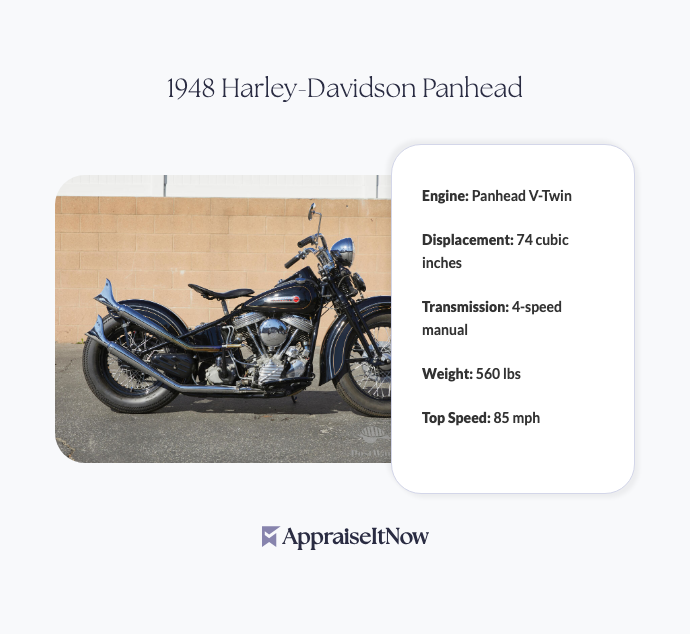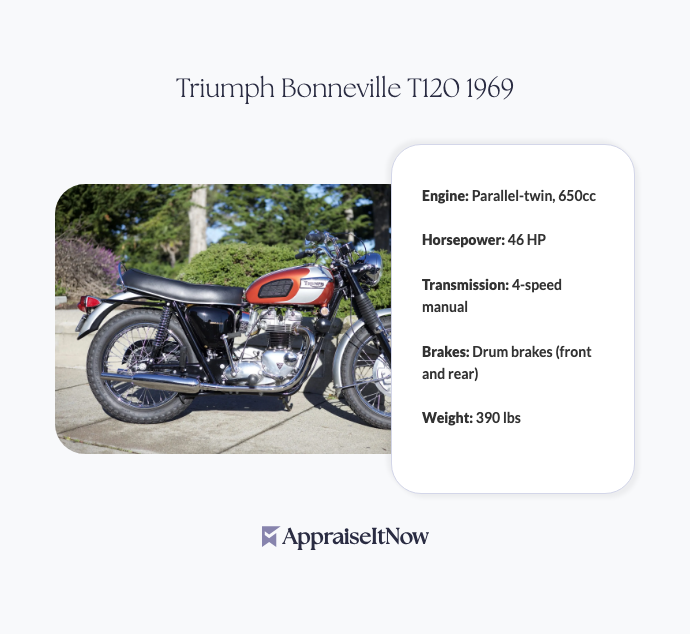<h1>How to Get Your 1948 Harley-Davidson Panhead Appraised</h1>
<p>If you own a 1948 Harley-Davidson Panhead, you likely understand that you're sitting on more than just a motorcycle—you're holding a piece of American motorcycling history. Whether you're considering selling, need insurance coverage, or simply want to know what your bike is worth, getting a professional appraisal is essential. The 1948 Harley-Davidson Panhead represents the inaugural year of one of the most iconic engines ever produced, and its market value typically ranges from <strong>$15,000 to $25,000</strong>, depending on condition, originality, and provenance.</p>
<h2>Understanding the 1948 Panhead's Market Value</h2>
<p>The 1948 Harley-Davidson Panhead commands significant collector interest because it marks the first year of production for an engine that would define a generation. Named for its distinctive rocker covers that resemble a frying pan, the Panhead engine became legendary for its rugged reliability and powerful V-twin performance. First-year models hold particular appeal among enthusiasts because they represent a technological milestone in Harley-Davidson's storied heritage.</p>
<p>What makes the 1948 model so valuable? Its historical significance as the debut year, combined with the engine's proven track record over the next 17 years of production (1948-1965), creates substantial collector demand. When evaluating how much a 1948 Harley-Davidson is worth, appraisers consider far more than just age—they examine condition, originality, documented service history, and market comparables.</p>
<div class="callout tip"><p><strong>Market Insight</strong></p>
<p>First-year production Panheads with documented ownership history and original parts can command premiums of 15-25% above standard market pricing.</p></div>
<h2>Key Factors Affecting Your Panhead's Appraisal Value</h2>
<h3>Condition and Originality</h3>
<p>The condition of your 1948 Panhead directly impacts its appraised value. A meticulously maintained original bike with unmodified engine components, factory finishes, and matching serial numbers will appraise significantly higher than a heavily customized or restored example. Appraisers examine the quality of any restoration work—original restorations using period-correct parts and techniques preserve value far better than modern modifications or aftermarket upgrades.</p>
<p>Original chrome and steel construction, while requiring careful maintenance, authenticates your Panhead as a genuine first-year example. Paint finish, seat condition, and tire authenticity all factor into the comprehensive evaluation that determines whether your bike sits at the lower end ($15,000) or upper range ($25,000) of the valuation spectrum.</p>
<h3>Engine Matching and Documentation</h3>
<p>The Panhead engine's legendary reliability stems from its innovative hydraulic valve lifters and distinctive rocker box design. When appraising your 1948 Panhead, experts verify that engine number matches the frame number, establishing authenticity and originality. This matching documentation can increase value by 10-20% compared to bikes with replaced or non-original engines.</p>
<p>Service records, original registration documents, and any historical maintenance logs strengthen your Panhead's provenance. Professional appraisers specializing in <a href="/types/motorcycle">motorcycles</a> appreciate detailed documentation that traces the bike's ownership chain and mechanical history. This creates a compelling narrative that collectors value highly.</p>
<h3>Production Year and Series Details</h3>
<p>The 1948 Panhead sits at the pinnacle of first-year desirability. If you're asking "which Harleys hold their value," the answer consistently points to early production Panheads alongside Knucklehead models from the 1930s and 1940s. The question of what makes a Panhead special has a straightforward answer: this engine design represented a revolutionary leap in motorcycle engineering, combining reliability with performance in ways that competitors couldn't match.</p>
<p>Later model years (1949-1965) maintain strong value but don't command the historical premium associated with the 1948 inaugural production. Understanding this distinction helps explain why your bike represents such a significant collectible asset within the broader category of <a href="/blog/appraising-classic-and-vintage-motorcycles-determining-collectible-bike-worth">vintage motorcycles</a>.</p>
<table class='appraisal-table'>
<thead>
<tr>
<th>Aspect</th>
<th>Impact on Value</th>
<th>Details</th>
</tr>
</thead>
<tbody>
<tr>
<td>Original engine/frame</td>
<td>+15-25%</td>
<td>Matching numbers verify authenticity</td>
</tr>
<tr>
<td>Factory paint/chrome</td>
<td>+10-15%</td>
<td>Period-correct finishes preferred</td>
</tr>
<tr>
<td>Service documentation</td>
<td>+5-10%</td>
<td>Maintenance history adds credibility</td>
</tr>
<tr>
<td>Restoration quality</td>
<td>Variable</td>
<td>Original restorations preserve value</td>
</tr>
</tbody>
</table>
<h2>What Influences Panhead Valuation Beyond Specs</h2>
<h3>Historical Significance and Cultural Impact</h3>
<p>The 1948 Panhead transcends mere transportation—it embodies the post-World War II American motorcycle renaissance. As the first year of a legendary engine design, your Panhead represents a technological turning point that collectors deeply appreciate. This historical weight justifies valuations that often exceed comparable bikes from other manufacturers, similar to how <a href="/blog/appraising-vintage-and-collectible-cars-determining-their-true-worth">vintage and collectible cars</a> command premiums based on historical significance.</p>
<p>Many collectors ask what makes a Knucklehead collectible—and the answer applies equally to Panheads: heritage, reliability, and cultural resonance. Your 1948 Panhead carries all three, making it highly desirable across generations of enthusiasts seeking to own a piece of motorcycling history.</p>
<div class="callout note"><p><strong>Collector Perspective</strong></p>
<p>The most sought-after Harley models combine engineering innovation with proven longevity, and the 1948 Panhead excels in both categories.</p></div>
<h3>Regional Market Variations</h3>
<p>Harley-Davidson values fluctuate based on regional collector density and motorcycle culture. Areas with strong vintage motorcycle communities often see higher valuations, while regions with less active collector interest may support more conservative appraisals. Professional appraisers account for these geographic variations when providing market-based valuations.</p>
<p>The question of what the most sought-after vintage motorcycle is doesn't have a single answer, but the 1948 Harley-Davidson Panhead consistently ranks among the top choices. Its combination of rarity, performance, and cultural significance creates strong demand across the United States and internationally, particularly within Commonwealth countries where Harley-Davidson maintains devoted collector bases.</p>
<h2>Preparing Your Panhead for Professional Appraisal</h2>
<h3>Documentation You Should Gather</h3>
<p>Before scheduling your appraisal, compile any available documentation that establishes your bike's authenticity and history. Original registration papers, service records, receipts from restoration work, and photographs from various points in ownership create a compelling provenance file. If you've performed maintenance or restoration yourself, document those activities with photos and detailed notes.</p>
<p>Photography plays a critical role in appraisal documentation. Take high-resolution images of the engine, frame, both sides of the motorcycle, detail shots of distinctive features, and any identifying marks or serial numbers. These photographs become part of your permanent appraisal record and prove invaluable for insurance purposes.</p>
<h3>Physical Condition Assessment</h3>
<p>Clean your Panhead thoroughly before appraisal, but avoid aggressive polishing that might damage original finishes. Appraisers can better evaluate true condition when the bike is clean, and your attention to presentation demonstrates respect for the motorcycle's historical significance. Ensure all mechanical systems function properly—a running Panhead appraises higher than one with mechanical issues requiring repair.</p>
<p>Check that all original components remain intact, from the carburetor to the ignition system. Missing or replaced parts reduce value proportionally, so document any non-original elements candidly for your appraiser. This transparency builds trust and ensures your appraisal reflects realistic market value rather than optimistic estimates.</p>
<h2>Why Professional Appraisal Matters</h2>
<h3>Insurance and Legal Documentation</h3>
<p>A certified appraisal from credentialed experts provides the documentation required by insurance companies for proper coverage. When seeking appropriate coverage for your 1948 Panhead, insurers require professional valuation that establishes replacement cost based on current market conditions. This protects your investment and ensures that if loss or damage occurs, you receive compensation reflecting true value.</p>
<p>Professional appraisals also serve critical roles in estate planning, divorce proceedings, and investment documentation. When personal property appraisals matter most is precisely when emotions run high and objectivity becomes essential—a certified appraiser provides neutral, defensible valuations that all parties respect.</p>
<h3>Market Comparables and Expertise</h3>
<p>Professional appraisers specializing in <a href="/types/personal-property">personal property</a> maintain databases of recent sales, auction results, and private transactions that establish fair market value. They understand how the 1948 Panhead's value compares to other iconic Harley models and can contextualize your specific bike's worth within the broader collector market. This expertise, combined with USPAP-compliant methodology, creates appraisals that withstand scrutiny from insurance companies, courts, and tax authorities.</p>
<p>The question "how much is a 1948 Harley-Davidson worth?" cannot be answered with a simple number—professional appraisers understand that values fluctuate based on specific condition, originality, and market timing. Their detailed analysis transforms that broad $15,000-$25,000 range into a precise valuation for your particular motorcycle.</p>
<div class="callout tip"><p><strong>Professional Advantage</strong></p>
<p>AppraiseItNow connects you with certified appraisers who specialize in motorcycles and maintain the credentials (AAA, ISA, ASA, CAGA, AMEA) that insurance companies and legal institutions recognize.</p></div>
<h2>Finding the Right Appraiser for Your Panhead</h2>
<h3>Credentials and Specialization</h3>
<p>When selecting an appraiser, verify their credentials and experience with vintage motorcycles. Look for professionals with AAA, ISA, ASA, CAGA, or AMEA certification—these credentials indicate adherence to professional standards and USPAP compliance. An appraiser who regularly evaluates Harley-Davidson motorcycles understands the nuances of different models, production years, and market dynamics in ways a generalist cannot match.</p>
<p>Ask potential appraisers about their experience with 1948 Panheads specifically. Those who can discuss first-year production characteristics, common restoration challenges, and current market trends demonstrate the specialized knowledge that produces accurate, defensible valuations. Don't hesitate to request references from previous clients or ask about their appraisal methodology.</p>
<h3>The Appraisal Process</h3>
<p>A thorough appraisal involves detailed inspection, photography, mechanical assessment, and market research. The appraiser examines your Panhead's condition, verifies engine and frame numbers, documents originality, and photographs distinctive features. This comprehensive evaluation takes time—expect the process to require 2-3 hours or potentially an on-site visit for valuable motorcycles.</p>
<p>The resulting appraisal report includes detailed condition description, comparable sales analysis, market value conclusion, and professional certification. This document becomes your permanent record, serving insurance, legal, and transaction purposes for years to come.</p>
<h2>Understanding Your Panhead's Investment Potential</h2>
<p>Harley-Davidson Panheads have demonstrated consistent appreciation over decades, particularly first-year models like your 1948 example. While not every motorcycle maintains value equally, Panheads benefit from strong collector demand, limited production numbers, and proven mechanical reliability. When collectors ask which Harleys hold their value, Panheads consistently rank among the top performers alongside Knucklehead and early Shovelhead models.</p>
<p>The trajectory of Panhead values reflects broader trends in vintage motorcycle collecting, where authentic examples with documented provenance command premium prices. Your 1948 Panhead represents not just a mode of transportation but a tangible investment in automotive history, protected by its unique position as the first year of production for a legendary engine design.</p>
<hr />
<div class="callout note"><p><strong>Key Takeaway</strong></p>
<p>A professional appraisal of your 1948 Harley-Davidson Panhead provides essential documentation for insurance, sale, or estate planning purposes. By establishing accurate market value through USPAP-compliant evaluation, you gain confidence in your ownership decisions and ensure your investment receives proper protection and recognition.</p></div>







.avif)







